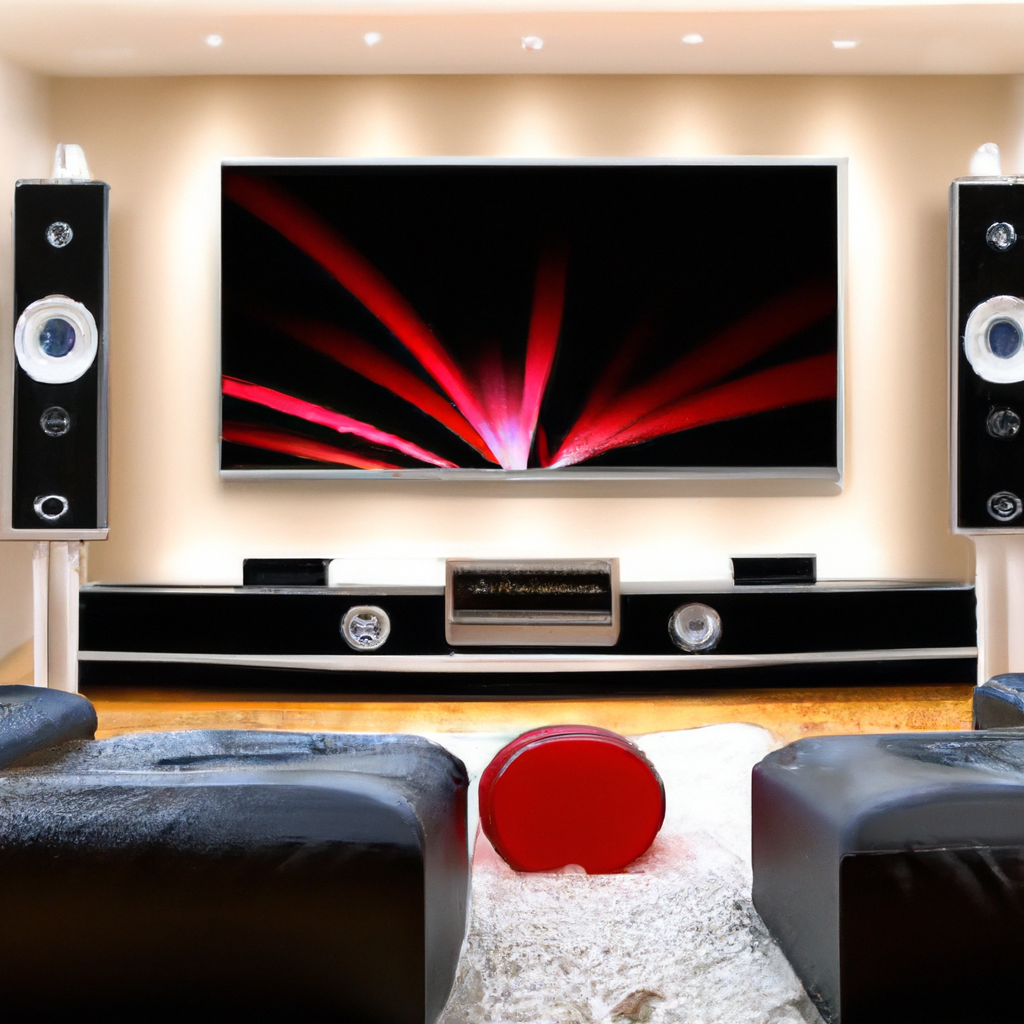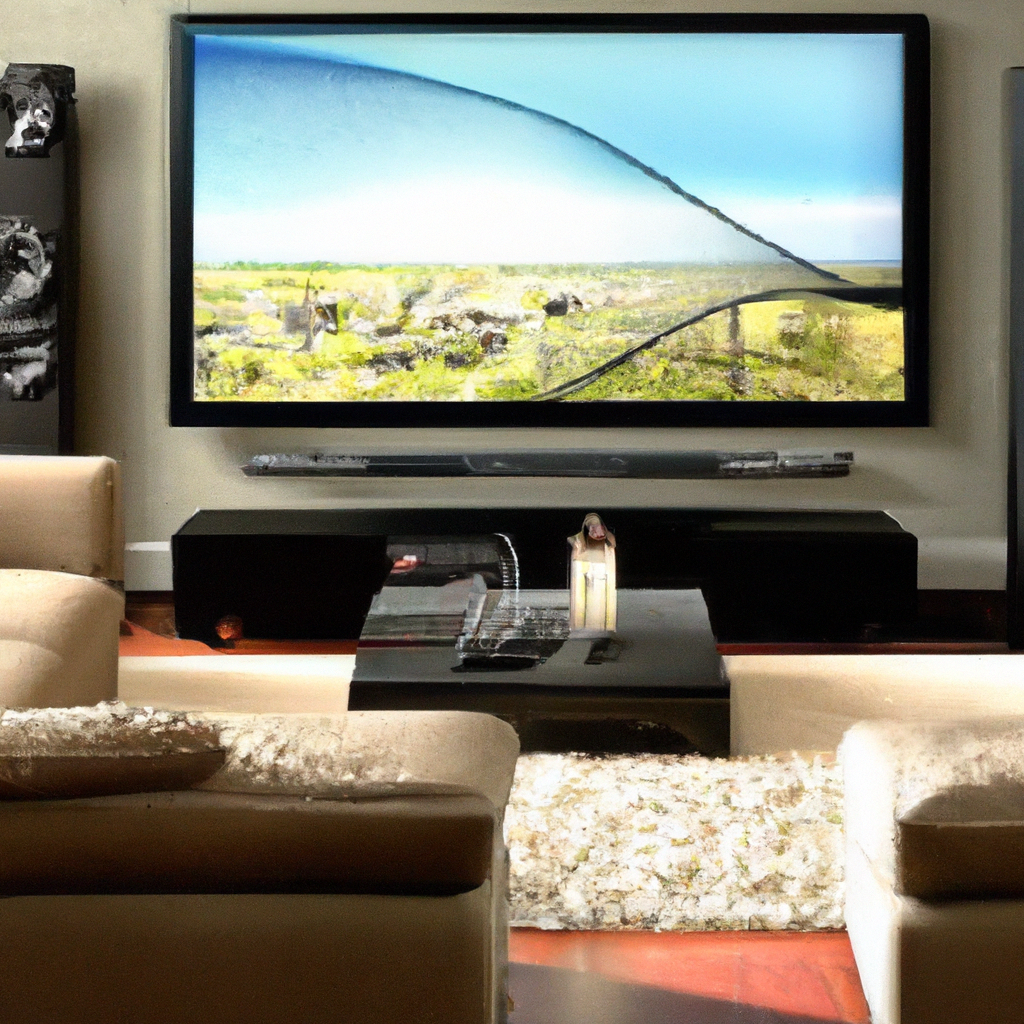Imagine transforming your living room into a captivating cinema experience, right from the comforts of your own home. A smart home theatre system is the perfect solution to make this dream a reality. From high-quality audio to crystal-clear visuals, this article will explore the essential components that make up a smart home theatre system. Prepare to immerse yourself in an unparalleled entertainment experience, all at the touch of a button. Get ready to unlock the full potential of your home theatre setup.

1. Television or Projector
When it comes to setting up a home theatre system, one of the first decisions you’ll need to make is whether to go with a television or a projector. Both options have their own advantages and it ultimately comes down to personal preference and the size of your space.
1.1 Size and resolution
Televisions are available in a wide range of sizes, from compact screens suitable for smaller rooms to massive screens that can rival the experience of a movie theater. The resolution of the TV is also an important factor to consider. You can choose from Full HD (1080p), 4K Ultra HD, or even the latest 8K resolution for a truly immersive viewing experience.
On the other hand, projectors offer the flexibility to project a much larger image onto a screen or wall, giving you a true cinematic experience. With projectors, you can easily achieve screen sizes of 100 inches or more, making it ideal for dedicated home theatre rooms or larger living spaces.
1.2 Display technology
When selecting a television, you’ll have a variety of display technologies to choose from. LED, OLED, and QLED are the most common options, each offering different advantages in terms of picture quality, color accuracy, and contrast ratios. LED TVs are generally more affordable, while OLED and QLED TVs tend to provide a higher level of visual performance.
Projectors, on the other hand, use technologies like DLP (Digital Light Processing) and LCD (Liquid Crystal Display). DLP projectors offer excellent color accuracy and high contrast ratios, whereas LCD projectors tend to be more affordable and often come with higher brightness levels.
1.3 Mounting options
Mounting your television on a wall can help save space and create a cleaner, more streamlined look. Wall mounts come in various designs, such as fixed mounts, tilting mounts, and full-motion mounts. These options allow you to adjust the viewing angle and position of the TV to suit your preferences.
In the case of projectors, they can be ceiling-mounted for a permanent installation or used with portable stands for more flexibility. Ceiling mounts keep the projector out of the way and offer a centralized location for optimal viewing angles. Portable stands allow for easy relocation and can be useful if you want to use the projector in different rooms.
2. Audio System
The audio system is an essential component of any home theatre setup. To truly immerse yourself in the movie experience, you’ll need to consider the following aspects:
2.1 Receiver
A receiver acts as the central hub for your audio setup, receiving audio signals from various sources and distributing them to the speakers. Look for a receiver that supports the latest audio formats, such as Dolby Atmos or DTS:X, for a more three-dimensional and immersive sound experience. The receiver should also have multiple HDMI inputs to connect different devices, such as a Blu-ray player, gaming console, or streaming device.
2.2 Speakers
Choosing the right speakers is crucial to achieving high-quality audio. The most common setup for a home theatre system is a 5.1 surround sound system, consisting of five speakers (front left, front center, front right, rear left, rear right) and a subwoofer for deep bass. However, you can also opt for a 7.1 system or even a more advanced Dolby Atmos setup with ceiling or upward-firing speakers.
When selecting speakers, consider their power handling capabilities, frequency response, and sensitivity. Floor-standing speakers are a popular choice for the front channels, while bookshelf or wall-mounted speakers work well for the surround channels. The subwoofer should be capable of reproducing low-frequency sounds accurately for that extra rumble in action-packed scenes.
2.3 Soundbar or surround sound
If you’re looking for a simpler audio solution without the hassle of multiple speakers, a soundbar can be a great option. Soundbars provide a streamlined setup by combining various speakers and amplifiers into a single unit. While they may not offer the same level of audio immersion as a full surround sound system, soundbars have come a long way in terms of audio quality and virtual surround sound effects. Some soundbars even support wireless subwoofers for enhanced bass performance.
If space or budget constraints are a concern, a soundbar can be a practical and effective choice for your home theatre system. However, if you’re serious about audio and want a truly immersive experience, a traditional surround sound setup with dedicated speakers is the way to go.
3. Video Source
To enjoy your favorite movies, TV shows, and streaming content, you’ll need a reliable video source. Here are some popular options to consider:
3.1 Streaming devices
Streaming devices, such as Apple TV, Roku, or Amazon Fire TV, allow you to access a wide range of streaming platforms and apps. These devices connect to your TV or projector and provide access to popular streaming services like Netflix, Hulu, and Disney+. Look for streaming devices that support 4K streaming and HDR (High Dynamic Range) content for an enhanced visual experience.
3.2 Blu-ray or DVD player
If you have a collection of Blu-ray or DVD movies, a dedicated player is a must-have. Blu-ray players provide the highest quality video and audio playback for physical media, offering superior picture resolution and lossless audio formats. DVD players are more affordable and suitable if you primarily watch DVDs or have a limited budget.
3.3 Cable or satellite box
If you subscribe to cable or satellite TV services, a cable or satellite box is needed to receive and decode the television signals. These boxes typically connect to your TV or projector via HDMI and provide access to a variety of channels and on-demand content. Make sure the box supports HD or 4K resolution and has the necessary connectivity options for your specific setup.
4. Home Automation Hub
Creating a smart home theatre system involves integrating various devices and controlling them seamlessly. A home automation hub serves as the central control system for your smart home, allowing you to automate tasks, control devices, and create custom routines. Here’s what to consider:
4.1 Integration of devices
Look for a home automation hub that supports integration with different devices, including your television, audio system, streaming devices, and smart lighting. This way, you can control all aspects of your home theatre system from a single interface. Choose a hub that is compatible with popular smart home protocols like Zigbee and Z-Wave for broad device compatibility.
4.2 Voice control
Voice control is becoming increasingly popular in smart homes, and having it integrated into your home theatre system can make things even more convenient. Look for a home automation hub that supports voice assistants like Amazon Alexa or Google Assistant. With voice control, you can simply use verbal commands to turn on your TV, adjust the volume, or switch to a specific streaming service.
4.3 Automation routines
One of the key benefits of a home automation hub is the ability to create automation routines. For example, you can set up a routine that automatically turns on the lights, lowers the blinds, and starts playing your favorite movie when you say a specific command. Automation routines can add a touch of magic to your home theatre experience by simplifying complex actions into a single command or event trigger.

5. Media Streaming
Streaming content has become the norm for many people, and having a reliable media streaming setup is essential for a home theatre system. Consider the following aspects:
5.1 Wi-Fi or Ethernet connectivity
Most modern TVs and streaming devices offer Wi-Fi connectivity, allowing you to wirelessly connect to your home network and access streaming platforms. However, for the best streaming performance, it’s recommended to use a wired Ethernet connection whenever possible. Ethernet cables provide faster and more stable internet connectivity, ensuring smooth playback and minimizing buffering.
5.2 Streaming platforms
There are numerous streaming platforms available, each with its own unique content library and user interface. Popular options include Netflix, Amazon Prime Video, Hulu, Disney+, and many more. Consider your personal preferences and the range of content available on each platform when deciding which ones to subscribe to.
5.3 Local media servers
If you have a collection of movies and TV shows on your computer or network storage, a local media server can be a great addition to your home theatre system. Media server software, such as Plex or Kodi, allows you to organize and stream your media files directly to your TV or projector. This gives you easy access to your entire collection without the need for physical discs.
6. Lighting Control
Proper lighting control can greatly enhance your home theatre experience by setting the right mood and reducing eye strain. Consider the following options:
6.1 Smart lighting bulbs
Replace your traditional light bulbs with smart lighting bulbs that can be controlled remotely and dimmed to the desired level. This allows you to adjust the brightness and color temperature of your lights from the convenience of your seat. Look for bulbs that are compatible with popular smart home platforms, making it easy to integrate them into your home automation system.
6.2 Dimmable lights
If you prefer not to invest in smart lighting bulbs, consider installing dimmable lights in your home theatre. Dimming the lights partially or completely can create a more immersive environment, allowing you to focus entirely on the screen. A simple dimmer switch or a lighting control system can be used to adjust the brightness levels manually.
6.3 Lighting scenes
To further enhance the ambience of your home theatre, consider setting up lighting scenes. These scenes can be pre-programmed to adjust multiple lights in the room simultaneously, creating different atmospheres for different types of content. For example, you can have a “movie” scene that dims the lights and a “video gaming” scene that adds a bit of color to the room. Lighting scenes can be triggered manually or integrated into your home automation system for automated control.

7. Control Interface
Controlling all the devices in your home theatre system should be convenient and intuitive. Here are some popular control interface options to consider:
7.1 Remote control
A universal remote control can be a lifesaver, especially if you have multiple devices that need to be operated simultaneously. Look for a remote control that is programmable and able to control all the essential functions of your TV, audio system, and streaming devices. Some advanced universal remotes even offer touchscreen displays and the ability to create custom macros for automated tasks.
7.2 Smartphone or tablet app
Many devices, including televisions, audio systems, and streaming devices, have their own companion apps that allow you to control them using your smartphone or tablet. These apps provide additional features and customization options, such as creating playlists, adjusting audio settings, or even streaming content directly from your device. Check if your devices have dedicated apps available and ensure they are compatible with your smartphone or tablet before making a purchase.
7.3 Smart speakers or digital assistants
Smart speakers, such as Amazon Echo or Google Nest, offer another convenient control interface for your home theatre system. Through voice commands, you can control various aspects of your setup, including turning on or off devices, adjusting volume levels, or switching between different streaming services. Smart speakers can also be integrated with your home automation hub, allowing you to control your entire smart home using voice commands.
8. Acoustic Treatments
Achieving the perfect audio experience in your home theatre involves more than just choosing the right speakers. Consider implementing the following acoustic treatments to optimize sound quality:
8.1 Soundproofing
If you live in an apartment building or have nearby neighbors, soundproofing your home theatre room can be beneficial. Soundproofing materials, such as acoustic panels, can help reduce sound transmission and prevent sound from leaking out of your room. This allows you to enjoy your movies and music without disturbing others and minimizes external noise interference.
8.2 Absorption panels
To improve the overall sound quality within your home theatre room, consider adding absorption panels to the walls. These panels help to reduce echo and reverberation, ensuring a more accurate and balanced sound. They can be strategically placed on walls, behind the speakers, or in corners to optimize the acoustics of the room.
8.3 Audio equipment placement
The placement of your audio equipment, including speakers and subwoofers, can significantly impact the sound quality. Follow best practices, such as positioning the front speakers at ear level, angling the surround speakers towards the listening position, and experimenting with subwoofer placement to achieve the best possible audio performance. Proper equipment placement can enhance sound imaging, improve bass response, and create a more immersive listening experience.

9. Wiring and Connectivity
Proper wiring and connectivity are essential to ensure seamless operation of your home theatre system. Consider the following aspects:
9.1 HDMI cables
HDMI cables are the standard connection method for transmitting high-definition audio and video signals between devices. When choosing HDMI cables, opt for high-speed cables that are compatible with the latest HDMI specifications. Ensure that the cables are of sufficient length to reach the devices without strain and consider using wall cable management solutions for a cleaner and organized setup.
9.2 Ethernet cables
While Wi-Fi connectivity is convenient, a wired Ethernet connection can provide a more stable and reliable internet connection for streaming content and accessing online services. Install Ethernet cables in your home theatre room to connect devices that support wired connections, such as smart TVs, streaming devices, or gaming consoles. This will help minimize potential issues with buffering or dropped connections.
9.3 Power outlets and surge protectors
Make sure you have enough power outlets available near your home theatre setup to connect all your devices. Consider using surge protectors to safeguard your equipment against power surges and voltage fluctuations. It’s also a good idea to organize and manage your power cables using cable management solutions to prevent clutter and tripping hazards.
10. Comfort and Seating
Creating a comfortable and inviting atmosphere in your home theatre is essential for hours of enjoyable entertainment. Consider the following aspects:
10.1 Recliners or theater seats
Investing in recliners or dedicated theater seats can greatly enhance the comfort of your home theatre. Look for seats with built-in reclining mechanisms, adjustable headrests, and armrests to find the perfect seating position. Some seats even come with additional features like cup holders, USB charging ports, and LED lighting for added convenience.
10.2 Comfort accessories
Consider adding comfort accessories to your home theatre setup, such as throw blankets, pillows, or footrests. These small additions can enhance your comfort level during long movie marathons or gaming sessions. Additionally, blackout curtains or blinds can help create a darker environment and reduce glare on the screen for a more immersive viewing experience.
10.3 Temperature control
Maintaining a comfortable temperature in your home theatre is important for a pleasant viewing experience. Consider installing a thermostat or smart temperature control system to regulate the temperature in the room. This allows you to easily adjust the temperature to your liking, ensuring you stay cozy during winter movie nights or cool during hot summer days.
In conclusion, a smart home theatre system consists of several key components that work together to create an immersive and enjoyable entertainment experience. From choosing the right television or projector to optimizing audio and video sources, integrating home automation, and enhancing the overall comfort of your space, each component plays a crucial role. By carefully considering each aspect and selecting the options that best suit your preferences and budget, you can create a personalized home theatre system that brings the magic of the big screen right into your living room.











